Click image for BBB rating
See our Privacy Policy
cool="cool" width="864" height="9953" border="0" cellpadding="0" cellspacing="0" gridx="16" showgridx="showgridx" usegridx="usegridx" gridy="16" showgridy="showgridy" usegridy="usegridy" bgcolor="#99ccff">
|
|
|
 |
|
|
|
|
|
|
Welcome to Spaightwood Galleries, Inc.
120 Main Street, Upton MA 01568-6193
You can follow us on Facebook athttp://www.facebook.com/pages/Spaightwood-Galleries-Inc/122951564441757
Old Master Prints: Ovid in Venice, 1497-1501
|
|
|
|
|
Many years ago, we purchased a group of nine woodcuts depicting some of the stories told in Ovid's Metamorphoses and recently we added three more. On stylistic grounds, we assigned them to the period of c. 1490 to 1500 and, on the basis of their similarity to the woodcuts in the triumph of Venetian printing, Francesco Colonna's Hypnerotomachia. The Strife of Love in a Dream, we tentatively placed them in Venice. REcently, relaxing from updating our website, I glanced at Edith Wyss's The Myth of Apollo and Marsyas in the Art of the Italian Renaissance: An Inquiry into the Meaning of Images (Newark: University of Delaware Press, 1996), where, on p. 84, I came across a woodcut that was clearly very similar to ours. Lucantoniio Giunta, the publisher, took a a Tuscan paraphrase of Giovanne del Virgilio's 1377 allegorized prose narrative, added 52 woodcuts, and published the first Metamorphoses in Italian (by Giovanni Bonsignori), Ovidio metamorphoses vulgare in 1497 (reprinted in 1501). This is not a text of Ovid but a presentation of its allegorized meaning. Sadly, we do not have the whole presentation, but only the woodcuts (some of which are trimmed out of their context) as works of art that must stand alone. The designer of the woodcuts (at least two woodcuts—both of which we have—show his monogram as "AI") chose not to present a single moment but to offer a sequences of incidents in one woodcut. Happily, we discovered on the University of Virginia's website (at http://etext.virginia.edu/Latin/ovid/ovidillust.html#cycles) a complete set of the woodcuts with the full-page visible (though not the versos).
The woodcuts were evidently quite popular because they were used again in Latin editions of Ovid with commentary in Latin published in 1505 and 1509, where they show very little wear from our earlier impressions. The woodcuts may have been based upon drawings made by Benedetto Montagna and may have been cut by Zoan Andrea il Veneziano and Nicolao da Modena. It is also possible that Mantegna's influence also may be included in their genealogy. Readers who prefer their Renaissance Ovids in English can enjoy the first complete translation into English by Arthur Golding (also a translator of Calvin and Luther), Ovid's Metamorphoses (1567), ed. John Frederick Nims (NY: Macmillan, 1965). Golding was in the employ of Sir Philip Sidney's uncle, the Earl of Leicester, and after Sidney's death he completed (or stole, according to Sidney's friend, Fulke Greville, later Lord Brooke), Sidney's translation of his friend Philip du Plessis de Mornay's A Woorke concerning the trewnesse of the Christian Religion (London, 1587). It is interesting to think about the mental flexibility of someone who could work on both Luther and Calvin, Ovid, and a French defense of the Christian religion, written by the future Henry IV's chief adviser and translated into English by the son of Queen Elizabeth's Lord Lieutenant of Ireland who was himself a courtier, a poet, a translator of the Psalms, a writer of sonnet sequences and a long prose fiction, and a general and governor of Flushing, given to the English by the rebellious Netherlandish rebels against Spain as security against a loan that Elizabeth made to them, a work that begins with general philosophical principles and moves to the revelation of the only truth in a Protestant understanding of Christianity.
These images offer a kind of baseline. They mark a moment when readers and viewers were just beginning to turn to works like Ovid's Metamorphoses not just for allegorized readings of classical texts as illustrating Christian mysteries as in the Old French Ovide Moralizé (both the verse version done in the 13th century or the prose version from the 15th century) but also out of a renewed interest in the old stories themselves which, by the last third of the 15th century had become the basis for paintings by artists like Botticelli, Giovanni Bellini, and Andrea Mantegna, and which in the works of 16th-century Venetian masters like Titian, Tintoretto, and Veronese become the subjects of beautiful, powerful, and moving works of art. All references to Ovid are to Charles Martin's translation of the Metamorphoses (NY: Norton, 2004).
|
|
|
|
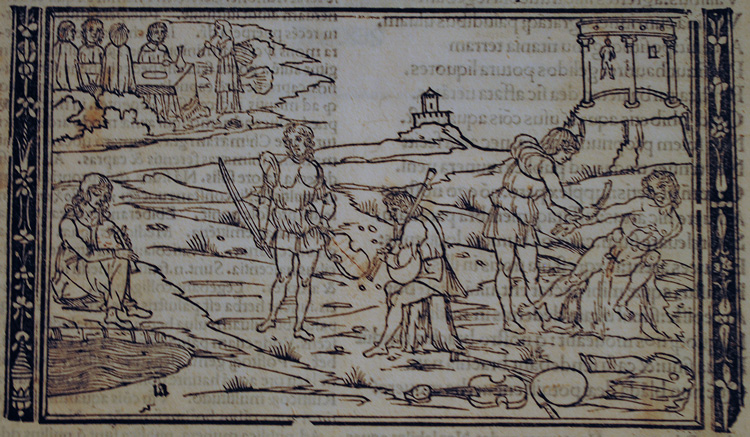 |
|
|
Venetian School, 1497. Apollo and Marsyas. Original woodcut, 1497, 1501, Venice. In the center foreground, Marsyis challenges Phoebus Apollo (standing with his lyre next to Marsyas, his cheeks puffed up as e blows into a bagpipe, an instrument fit for shepherds, not gods) to a singing contest. Apollo is nbot amused. After the contest, Apollo orders that Marsyas be flayed, a process we see at right (and upper right we can see his flayed sing hanging on the ittle hill behind the scene). After his flaying he is transformed into a stream. Signed "ia' Lower left. Image size: 89x142mm. This image is reproduced in Edith Wyss, The Myth of Apollo and Marsyas in the Art of the Italian Renaissance: An Inquiry into the Meaning of Images (Newark: University of Delaware Press, 1996), p. 84 (for discussion, see pp. 83-85) . Price: Please call or email for current pricing information.
|
|
|
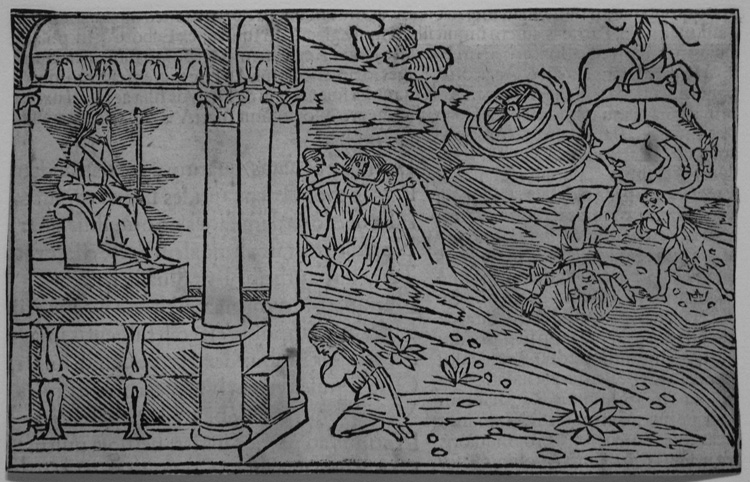 |
|
|
Venetian School, 1497, 1501. Apollo and Phaeton. Original woodcut, published in the first two editions of Ovidio metamorphoses vulgare in 1497 and 1501. In the left foreground, Phaeton kneels before his father Apollo and begs to be allowed to drive the chariot of the sun. In the top right, we see the fatal consequences of his inability to control the team: to save heaven and earth from being consumed by fire as the horses fly close enough to set palaces and fields on fire, Jupiter has blasted Phaeton with a thunderbolt. In the middle background, Phaeton's sisters rush forward in grief at the sight of their brother's fall from the heights (they will be transformed into Cypress trees by their grief). Phaeton became a symbol of pride and a warning that making claims beyond one's ability to fulfill them will lead to a downfall. See, for instance, Shakespeare's Richard II in the play of the same name: "Down, down I come like glist'ring Phaethon, / Wanting the manage of unruly jades. / In the base court: base court where kings grow base / To come at traitors' calls, and do them grace. / In the base court, come down: down court, down King, / For night-owls shriek where mounting larks should sing" (Richard II, III.iii.177-182). The story can be found in the Metamorphoses, Book I, starting at line 1039. Image size: 89x142mm. Price: Please call or email for current pricing information.
|
|
|
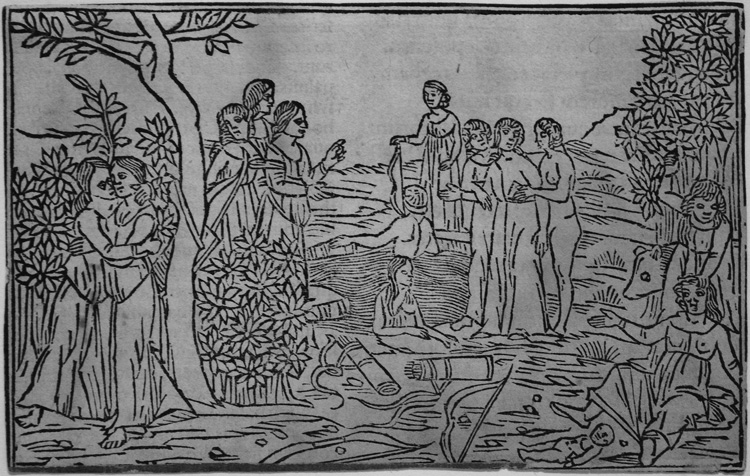 |
|
|
Venetian School, 1497, 1501. Callisto giving birth to Arcas. Original woodcut, published in the first two editions of Ovidio metamorphoses vulgare in 1497 and 1501. In the left foreground, Jupiter, disguised as Diana, seduces the nymph Callisto. She becomes pregnant and her pregnancy is discovered when she bathes in a pool after the hunt. Diana, a virgin goddess, is infuriated and transforms her into a bear. Her son, grown up, is out hunting one day when he comes across a giant bear (with a human mind). She recognizes him, he is terrified and tries to stab her with his spear. Jupiter intervenes and translates them to the heavens as Ursa Major and Ursa Minor, the great bear and the little bear. The story can be found in the Metamorphoses, Book II, starting at line 549. Image size: 91x143mm. Price: Please call or email for current pricing information.
|
|
|
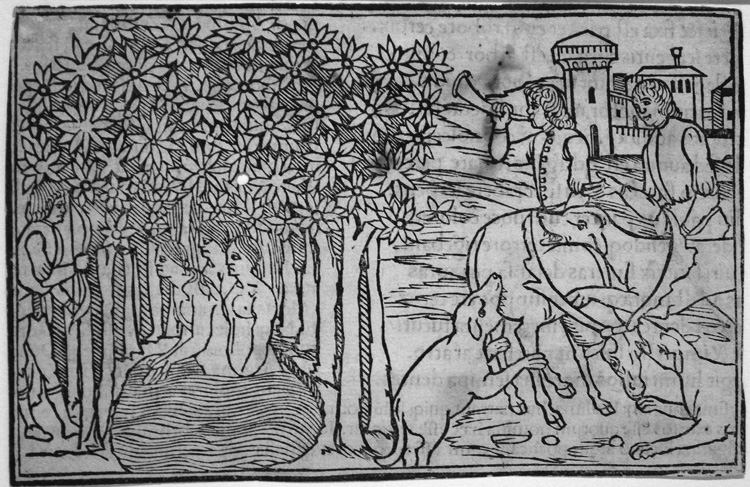 |
|
|
Venetian School, 1497, 1501. Actaeon and Diana. Original woodcut, published in the first two editions of Ovidio metamorphoses vulgare in 1497 and 1501. In the left foreground, Actaeon, a hunter, and therefore a worshipper of Diana's, has the misfortune ("so Fate had arranged") to come across the goddess bathing after the hunt. Diana, a virgin goddess, is infuriated and transforms him into a stag (Diana sprinkles water on him and transforms him into a stag—a hart, if one wants to play with the image as Shakespeare does in the opening scene of Twelfth Night—by flinging water on him and saying, "Now you may tell of how you saw me naked, / tell it if you can, you may." Inarticulately bemoaning his fate, his dogs come upon him and chase their fleeing master, ultimately catching him, bringing them down, and tear him to pieces with their teeth. The story can be found in the Metamorphoses, Book III, starting at line 163. Small hole in the leaves over the head of the right-hand nymph; small stain through the horn of the tracker at right. Image size: 91x143mm. Price: Please call or email for current pricing information.
|
|
|
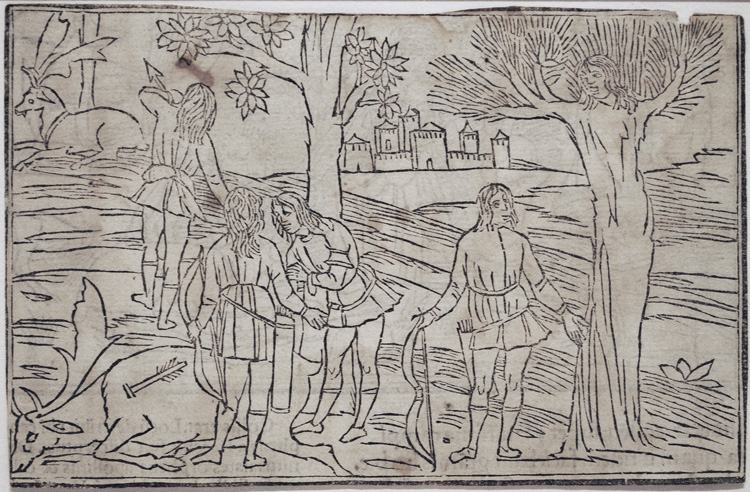 |
|
|
Venetian School, 1497. Cyparissus. Original woodcut, 1497, 1501, Venice. Cyparrisus loves an enormous stag (left) but killls him by acident. He desires to mourn his friend forever and is transforemed into a cyprus by Apollo (at right). Image size: 89x142mm. Price: Please call or email for current pricing information.
|
|
|
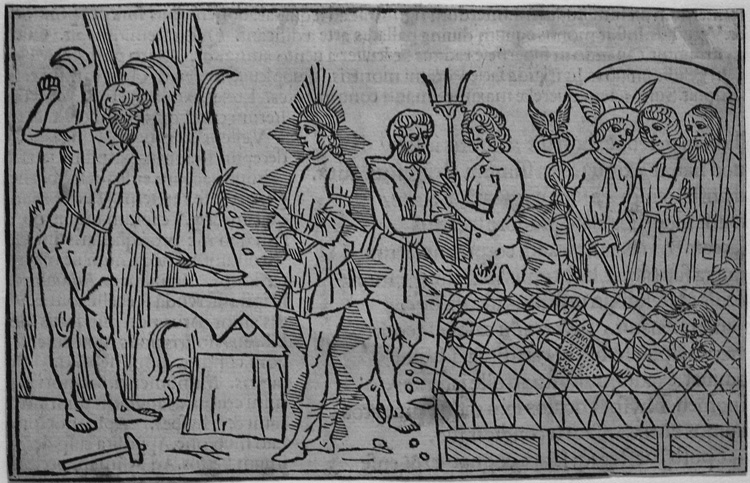 |
|
|
Venetian School, 1497, 1501. Vulcan captures Venus and Mars in his Net. Original woodcut, published in the first two editions of Ovidio metamorphoses vulgare in 1497and 1501. At left, Apollo, the all-seeing god of the Sun, tells Vulcan that he has just seen Venus, Vulcan's wife, having sex with Mars. Vulcan "devised a brilliant / trap for the guilty pair, a net of bronze links / so finely woven that it fooled the eye." Vulcan spreads his net across the bed and when the guilty lovers came to the couch again, "by her husband's art and by the chains he'd cleverly devised, / the two of them were caught in the very act, / clinging together in mutual embrace." Vulcan then invites all of the gods to observe Venus and Mars trapped in his net. From the left we see Neptune and Amphitrite, Mercury, a figure with a staff, and Saturn. The story can be found in the Metamorphoses, Book IV, starting at line 228. Small stain above Saturn's scythe. Reproduced in Anne W. Lowenthal, Joachim Wtewael: Mars and Venus Surprised by Vulcan , figure 35, p. 52 (Malibu: Getty Museum Studies on Art, 1995). Image size: 91x142mm. Price: Please call or email for current pricing information.
|
|
|
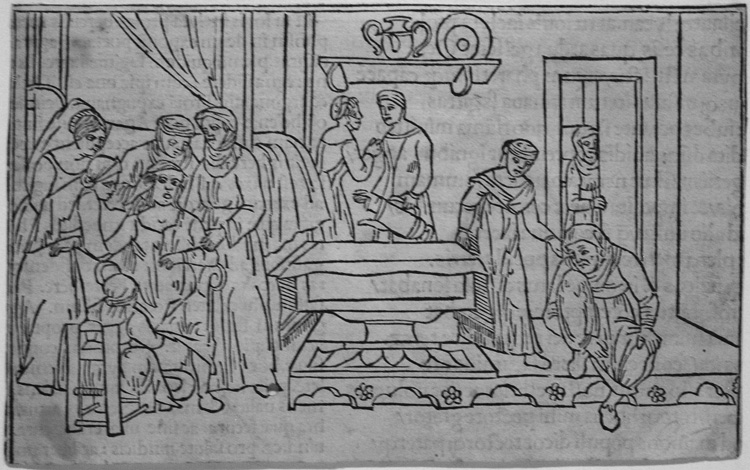 |
|
|
Venetian School, 1497. Hera revenges Jupiter's adultery with Alcmene by preventing the bnirth of Hercules. Original woodcut, 1497, 1501, Venice. In the left foreground, Alcmene, surrounded by her ladies-in-waiting, sits on the birthing stool with the attending midwife; at right, an older woman (Hera in disguise) prevents the moment pf birth. Image size: 89x142mm. Price: Please call or email for current pricing information.
|
|
|
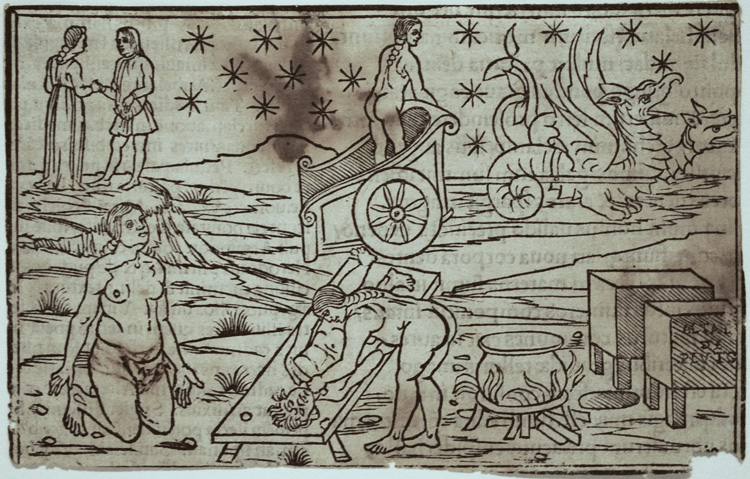 |
|
|
Venetian School, 1497, 1501. The story of Medea. Original woodcut, published in the first two editions of Ovidio metamorphoses vulgare in 1497and 1501. Upper left, after Jason promises to marry her if she helps him, Medea betrays her father and her country to help Jason. Jason and Medea return to his home in Thessaly, where they find his aged father Aeson near death. After praying to Hecate and "the gods who dwell below," again Medea helps Jason, using a magic potion she obtains from Hecate to rejuvenate Aeson. In the upper center, we see Medea in her chariot pulled by two dragons flying off to obtain the herbs she needs for her task. Praying for success, she stretches "the old man out on a bed" and slits his throat to drain his blood, which she replaces with her herbs, and rejuvenates him. The story can be found in the Metamorphoses, Book IV, lines 1-428. Condition: poor (bottom margins mostly missing, lower right corner torn, large stain upper center left. Image size: 87x143mm. Price: Please call or email for current pricing information.
|
|
|
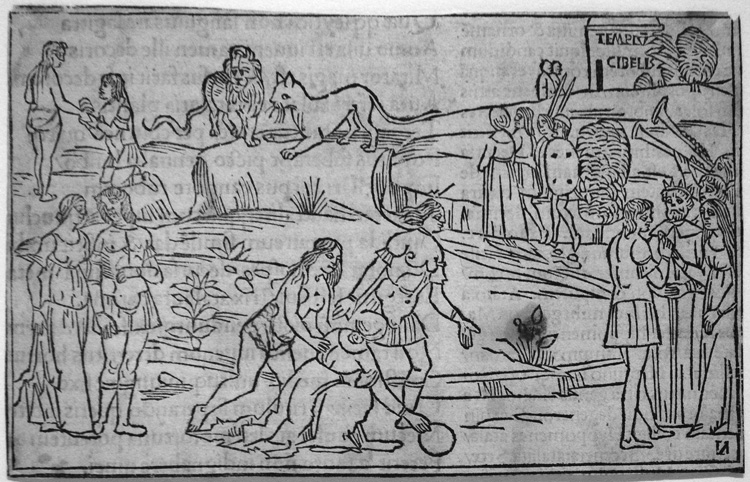 |
|
|
Venetian School, 1497. Atalante and Hippomanes. Original woodcut, 1497, 1501, Venice. This is a story told by Venus to Adonis warning him to avoiod lions and savage beasts "whom I despise altogether." Hippomanes sees Atalante, loves her, but she will only marry someone who can beat her in a race (and if they lose to her, they lose their life). Venus helps Hi[[omanes by giving him three golden apples and tells him to throw thm in front of her during their race, distracting her and allowing him to cross the finish line first. Unhappily, Hippomanes is so besotted with his new bride that he forgets to thank Venus. In response she moves inflames them with dessire and they make love in Cybele's temple (upper right) who is offended and transforms them into a pair of lions since they were beasts and defiled her temple. Signed "IA" lower right corner. Image size: 91x143mm. Price: Please call or email for current pricing information.
|
|
|
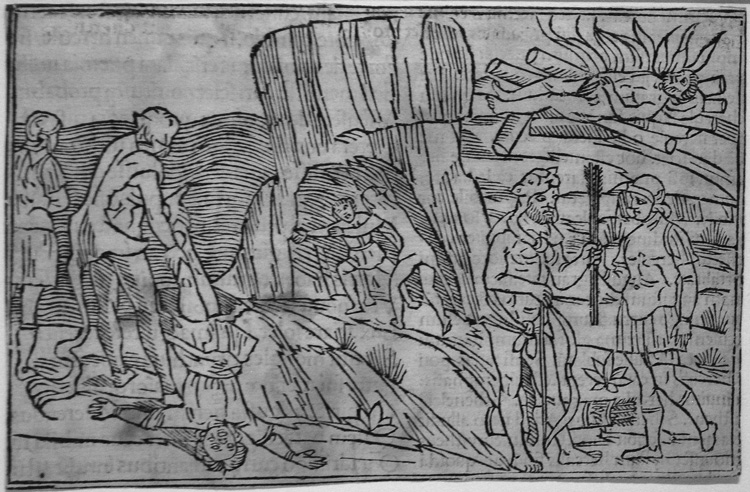 |
|
|
Venetian School, 1497, 1501. The story of Hercules. Original woodcut, published in the first two editions of Ovidio metamorphoses vulgare in 1497 and1501. At left, Hercules conquers Antaeus by keeping his mother Earth from rejuvenating him and drowns him in a lake. In the center, Hercules rescues Alceste from Hell, lower right he gives his bow and arrows to Philoctetes, and above right, all that is mortal of him is burned away after he is poisoned by a tunic given by the centaur Nessus to Hercules' wife, telling her it is a love charm. When she sends it to him, afraid that he will betray her, Hercules is in agony until after three days all that is left is his immortal part and Jupiter takes him up into the heavens as a god. The story can be found in the Metamorphoses, Book VII, 509ff and Book IX, 141-401. Image size: 91x143mm. Price: Please call or email for current pricing information.
|
|
|
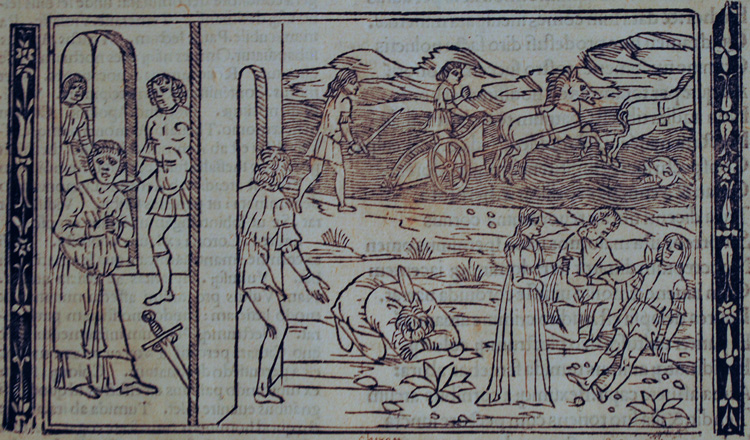 |
|
|
Venetian School, 1497. Phaedra and Hippolytus. Original woodcut, 1497, 1501, Venice. In the left foreground, Phaedra, filled with guilt and despair, prepares to commit suicide. Upper right, Hippolytus drives the chariot of the sun while Theseus, Phaedra's husband and Hippolytus's father, chases after him with his sword in hand; bottom right we see Hippolytus lying dead upon the ground after he lost control of the chariot and was wrecked upon the rocks in the seashore and drowned by the waves. We also see (at right) Esculapius bending over to heal him and, his name changed by the gods to Virbius, he lives a second life in obscurity. Image size: 89x142mm. Price: Please call or email for current pricing information.
|
|
|
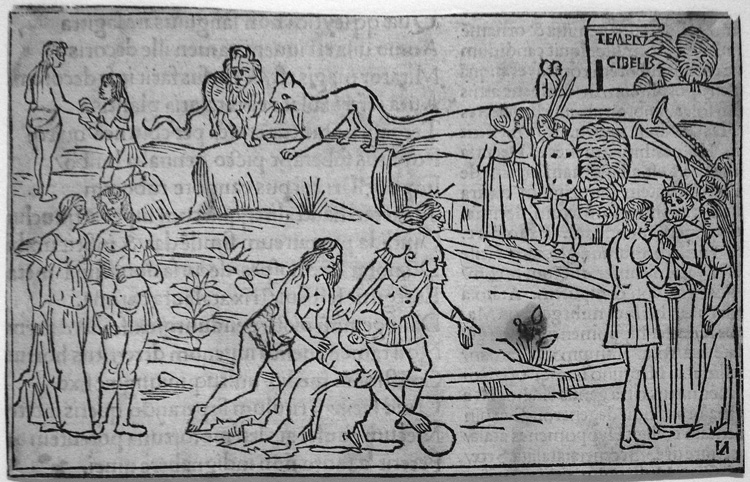 |
|
|
Venetian School, 1497, 1501. Atalanta, Hippomenes, Venus, and Cybele. Original woodcut, published in the first two editions of Ovidio metamorphoses vulgare in 1497 (reprinted in 1501). Venus, desperately in love with Adonis, tells him a story to warn him not to hunt dangerous animals. Atalanta, "a maiden able to vanquish / the swiftest of men in a footrace" (X, 667-68), asked "some god about husbands," and was told that she should "flee from a husband! / But you will not flee—and losing yourself, will live on." Atalanta withdrew from the society of men and said that if anyone wanted to marry her, he must first defeat her in a footrace; if he failed to do so, however, he would be put to death. Hippomenes prayed to Venus for help and received three golden apples with instructions to hurl them off the race course whenever Atalanta began to pass him. The ploy worked, abetted by Atalanta's love of pretty things and her love for Hippomenes. However, after Hippomenes won both the race and Atalanta, he neglected to thank Venus. Venus is offended: But really, Adonis, wasn't I worthty of being / thanked for my troubles? Offered a gift of sweeet incense? / Heedless of all I had done he offered me neither" (X, 795-797). Venus waits until they pass the Temple of Cybele (upper right) and fills them with desire; they "defile" the temple. Cybele "prepared to plunge the guilty pair in Stygian waters, / but that seemed too easy; so now their elegant pale necks / are cloaked in tawny manes; curved claws are their fingers; / arms are now forelegs, and all the weight of their bodies / shifts to their torsos"; now, instead of being husband and wife, they pull Cybele's chariot. Venus' moral to Adonis is "avoid these and all other wild beasts, / who will not turn tail, buit show off their boldness in battle; flee them or else your courage will prove our runi." Needless to say, Adonis instead goes hunting, is ripped apart by a boar, and Venus is left to mourn (but their story does provide Shakespeare with the matter for a poem, so their sacrifice ws not in vain). Small almost unobtrusive stain in the flower growing at right; part of the upper border lost. Signed "IA" lower right corner. The story can be found in the Metamorphoses, Book X, 667ff. Image size: 91x143mm. Price: Please call or email for current pricing information.
|
|
|
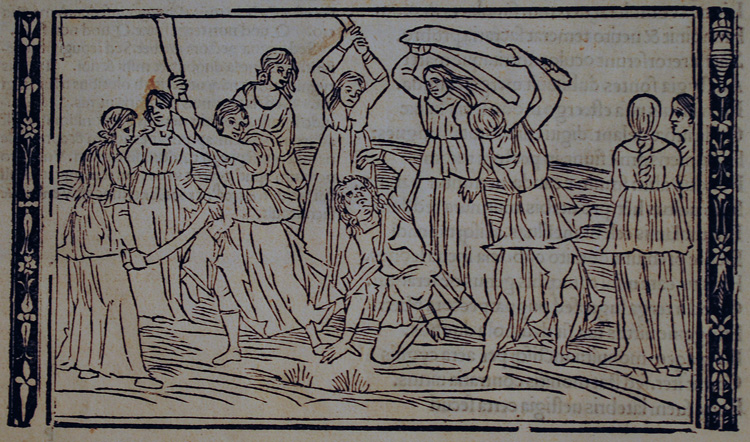 |
|
|
Venetian School, 1497. The Death of Orpheus. Original woodcut, 1497, 1501, Venice. After his failure to rescue Eurydice from Hades, Orpheus turns to singing the woes of love andd lovers' tragic ends. The women of the countryside become outraged with his rejection of love and kill him (thereby calling into question the effficacy of love poetry). Image size: 89x142mm. Price: Please call or email for current pricing information.
|
|
|
|
|
Spaightwood Galleries, Inc.
To purchase, call us at 1-800-809-3343 (1-508-529-2511 in Upton MA & vicinity) or send an email to spaightwood@gmail.com
We accept AmericanExpress, DiscoverCard, MasterCard, and Visa.
We also accept wire transfers and paypal.
For directions and visiting information, please call. We are, of course, always available over the web and by telephone (see above for contact information). Click the following for links to past shows and artists. For a visual tour of the gallery, please click here. For information about Andy Weiner and Sonja Hansard-Weiner, please click here. For a list of special offers currently available, see Specials.
All works are sold with an unconditional guarantee of authenticity (as described in our website listing).
Copyright 2004-2017, Spaightwood Galleries, Inc.
Go back to the top of this page.
Visiting hours: Saturday 10:00 am to 5:00 pm and Sunday noon to 6:00 pm and other times by arrangement.
Please call to confirm your visit. Browsers and guests are welcome.
|
|
|
|
|
|
|
|
|
|
|
|
|
|
|
|
|
|
|
|
|
|
|
|
|
|
|
|
|
|
|
|
|
|
|
|
|
|
|












